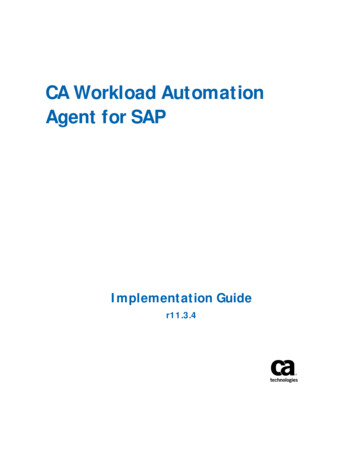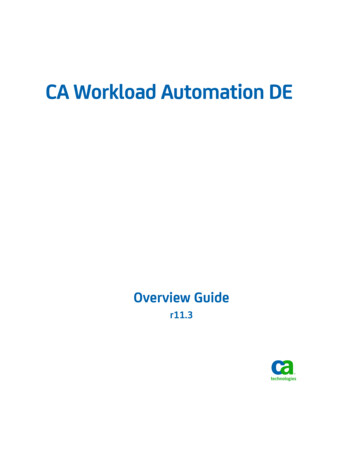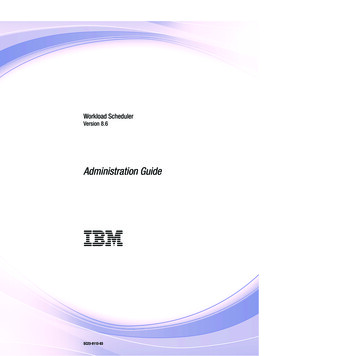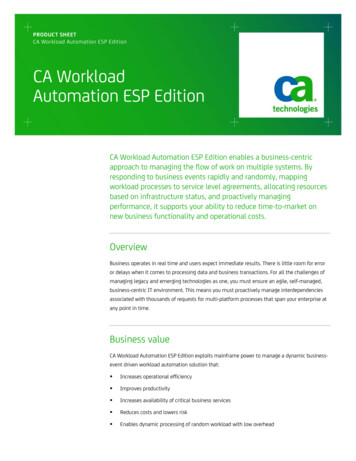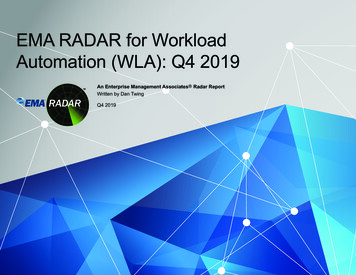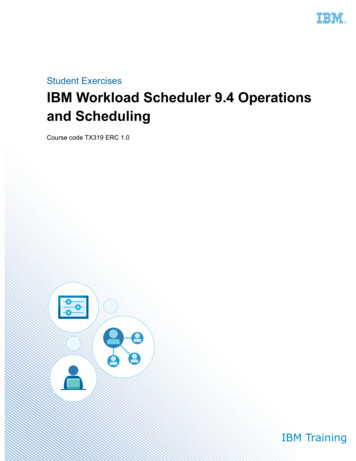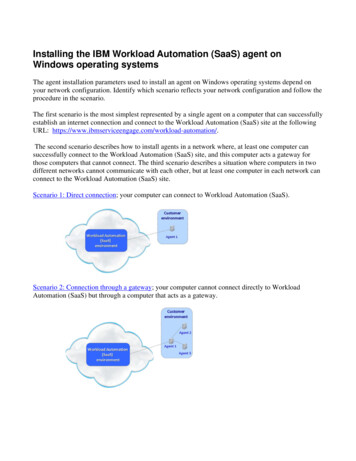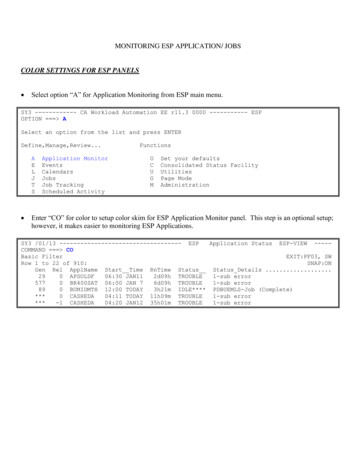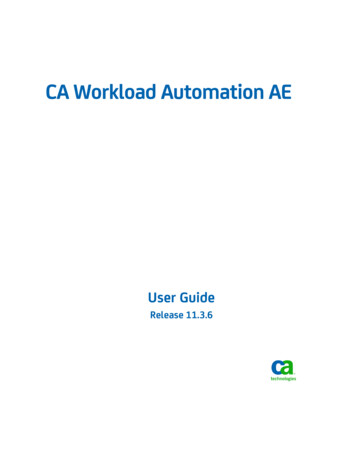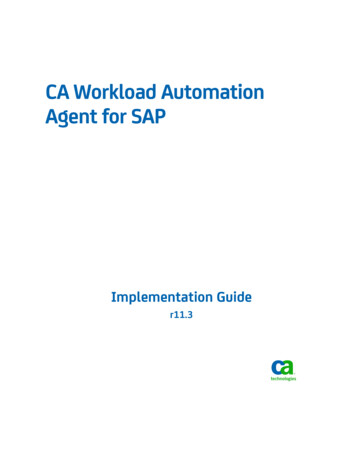
Transcription
CA Workload AutomationAgent for SAPImplementation Guider11.3
This Documentation, which includes embedded help systems and electronically distributed materials, (hereinafter referred toas the “Documentation”) is for your informational purposes only and is subject to change or withdrawal by CA at any time.This Documentation may not be copied, transferred, reproduced, disclosed, modified or duplicated, in whole or in part, withoutthe prior written consent of CA. This Documentation is confidential and proprietary information of CA and may not be disclosedby you or used for any purpose other than as may be permitted in (i) a separate agreement between you and CA governingyour use of the CA software to which the Documentation relates; or (ii) a separate confidentiality agreement between you andCA.Notwithstanding the foregoing, if you are a licensed user of the software product(s) addressed in the Documentation, you mayprint or otherwise make available a reasonable number of copies of the Documentation for internal use by you and youremployees in connection with that software, provided that all CA copyright notices and legends are affixed to each reproducedcopy.The right to print or otherwise make available copies of the Documentation is limited to the period during which the applicablelicense for such software remains in full force and effect. Should the license terminate for any reason, it is your responsibility tocertify in writing to CA that all copies and partial copies of the Documentation have been returned to CA or destroyed.TO THE EXTENT PERMITTED BY APPLICABLE LAW, CA PROVIDES THIS DOCUMENTATION “AS IS” WITHOUT WARRANTY OF ANYKIND, INCLUDING WITHOUT LIMITATION, ANY IMPLIED WARRANTIES OF MERCHANTABILITY, FITNESS FOR A PARTICULARPURPOSE, OR NONINFRINGEMENT. IN NO EVENT WILL CA BE LIABLE TO YOU OR ANY THIRD PARTY FOR ANY LOSS OR DAMAGE,DIRECT OR INDIRECT, FROM THE USE OF THIS DOCUMENTATION, INCLUDING WITHOUT LIMITATION, LOST PROFITS, LOSTINVESTMENT, BUSINESS INTERRUPTION, GOODWILL, OR LOST DATA, EVEN IF CA IS EXPRESSLY ADVISED IN ADVANCE OF THEPOSSIBILITY OF SUCH LOSS OR DAMAGE.The use of any software product referenced in the Documentation is governed by the applicable license agreement and suchlicense agreement is not modified in any way by the terms of this notice.The manufacturer of this Documentation is CA.Provided with “Restricted Rights.” Use, duplication or disclosure by the United States Government is subject to the restrictionsset forth in FAR Sections 12.212, 52.227-14, and 52.227-19(c)(1) - (2) and DFARS Section 252.227-7014(b)(3), as applicable, ortheir successors.Copyright 2010 CA. All rights reserved. All trademarks, trade names, service marks, and logos referenced herein belong totheir respective companies.
CA Technologies Product ReferencesThis document references the following CA Technologies products: CA Process Automation CA Workload Automation AE CA Workload Automation Agent for Application Services (CA WA Agent forApplication Services) CA Workload Automation Agent for Databases (CA WA Agent for Databases) CA Workload Automation Agent for i5/OS (CA WA Agent for i5/OS) CA Workload Automation Agent for Linux (CA WA Agent for Linux) CA Workload Automation Agent for Micro Focus (CA WA Agent for Micro Focus) CA Workload Automation Agent for Microsoft SQL Server (CA WA Agent forMicrosoft SQL Server) CA Workload Automation Agent for Oracle E-Business Suite (CA WA Agent forOracle E-Business Suite) CA Workload Automation Agent for PeopleSoft (CA WA Agent for PeopleSoft) CA Workload Automation Agent for Remote Execution (CA WA Agent for RemoteExecution) CA Workload Automation Agent for SAP (CA WA Agent for SAP) CA Workload Automation Agent for UNIX (CA WA Agent for UNIX) CA Workload Automation Agent for Web Services (CA WA Agent for Web Services) CA Workload Automation Agent for Windows (CA WA Agent for Windows) CA Workload Automation CA 7 Edition CA Workload Automation DE CA Workload Automation Desktop Client (CA WA Desktop Client) CA Workload Automation ESP Edition CA Workload Control Center
Contact CA TechnologiesContact CA SupportFor your convenience, CA Technologies provides one site where you can access theinformation that you need for your Home Office, Small Business, and Enterprise CATechnologies products. At http://ca.com/support, you can access the followingresources: Online and telephone contact information for technical assistance and customerservices Information about user communities and forums Product and documentation downloads CA Support policies and guidelines Other helpful resources appropriate for your productProviding Feedback About Product DocumentationIf you have comments or questions about CA Technologies product documentation, youcan send a message to techpubs@ca.com.To provide feedback about CA Technologies product documentation, complete ourshort customer survey which is available on the CA Support website athttp://ca.com/docs.
ContentsChapter 1: Introduction9Intended Audience . 9Agents and Agent Plug-ins . 9CA WA Agent for SAP . 10Agent Plug-in Communication with SAP . 11Job Types Supported by CA WA Agent for SAP . 11Chapter 2: Implementation Checklist13How to Install and Configure CA WA Agent for SAP. 13Collecting Information for Your SAP System . 14Deciding Whether to Create an Alias . 14Chapter 3: Installing the Agent Plug-in17SAP Agent Plug-in Installation Options . 17Controlling the Agent Plug-in . 19Install CA WA Agent for SAP . 19Install the SAP Java Connector (SAP JCo) . 20Modify the cybAgent file (for AIX and Solaris) . 21How to Remove the Agent Plug-in . 22Disable CA WA Agent for SAP. 22Remove the Agent Plug-in from the Scheduling Manager . 24Chapter 4: Configuring the SAP System25How to Install the ABAPs for the Agent Plug-in . 25Collecting Information Required to Install the ABAPs . 25Install the ABAPs on an SAP System . 26ABAPs for the Agent Plug-in . 27Initialize XBP 2.0 Functionality . 27How to Switch SAP Operational Mode . 28Chapter 5: Your Scheduling Manager and the Agent Plug-in29Configuring the Scheduling Manager to Work with the Agent Plug-in . 29Running a Verification Test . 29Contents 5
Chapter 6: Configuring the Agent Plug-in31How to Configure Agent Parameters . 31Configure Agent Parameters on the Agent . 32Configure Agent Parameters on the Scheduling Manager. 32CA WA Agent for SAP Parameters in the agentparm.txt File . 33How to Set Up an Alias for the Agent Plug-in . 39Create an Alias for the Agent Plug-in . 40Configuring an Alias on the Scheduling Manager . 40Set Default Values for SAP Jobs . 41Encrypt the SAP Password . 42Set SAP Connection Parameters . 43How to Configure Load Balancing . 45Configure the Agent Plug-in to Connect with Load Balancing . 45Configure the Server for Symbolic Port Name Translation . 47Define Additional SAP System Connections . 48Clearing the FTP and Spool Files Automatically . 48FTP Response Files . 49SAP Spool Files . 49Enable Regular Expressions to Check Spool File Messages . 49Chapter 7: Setting Up SAP Authorizations51General Authorizations . 51Authorization for Extending XBP Functionality . 55Authorization for Data Archiving Jobs . 56Authorization for Batch Input Session (BDC) Jobs . 57Authorization for Business Warehouse (BW) Jobs . 57Sample Screenshot for Authorizations . 59Chapter 8: Troubleshooting the Agent Plug-in61Agent Plug-in is Unable to Communicate with the SAP System . 61Configuration Analyzer Validation Checks . 61Message Types . 62SAP-related Log Files . 62Increase the Polling Rate when SAP is Slow to Respond . 63Handle Slow SAP Connections . 63Close Failed Connections. 63Wrong State Reported for an SAP BW Process Chain . 646 Implementation Guide
Chapter 9: Related Documentation65CA Workload Automation AE Documentation . 65CA Workload Automation DE Documentation . 66CA Workload Automation ESP Edition Documentation . 66CA Workload Automation CA 7 Edition Documentation . 67Index69Contents 7
Chapter 1: IntroductionThis section contains the following topics:Intended Audience (see page 9)Agents and Agent Plug-ins (see page 9)CA WA Agent for SAP (see page 10)Agent Plug-in Communication with SAP (see page 11)Job Types Supported by CA WA Agent for SAP (see page 11)Intended AudienceThis document is for system administrators who are responsible for upgrading,installing, and configuring agents.You require knowledge of the operating system where the agent is installed and anythird-party products or software technology that the agent uses.Notes: The term Windows refers to any Microsoft Windows operating system supported bythe agent. The UNIX instructions in this document also apply to Linux systems unless otherwisenoted.Agents and Agent Plug-insAgents are the key integration components of CA Technologies workload automationproducts. Agents let you automate, monitor, and manage workload on all majorplatforms, applications, and databases. To run workload on a particular system, youinstall an agent on that system. If your workload must run on a UNIX computer, forexample, you can install and configure the CA WA Agent for UNIX. The agent lets yourun UNIX scripts, execute UNIX commands, transfer files using FTP, monitor file activityon the agent computer, and perform many other tasks.You can extend the functionality of the agent by installing one or more agent plug-ins inthe agent installation directory. If you have a relational database such as Oracle, forexample, you can install a database agent plug-in to query and monitor the database.Other agent plug-ins are also available. For more information about agent plug-ins, seethe Implementation Guide for the appropriate agent plug-in.Note: The agent plug-ins are only available for UNIX, Linux, and Windows operatingenvironments.Chapter 1: Introduction 9
CA WA Agent for SAPExample: Workload with Different Types of JobsThe following workload contains z/OS jobs, a UNIX job, an SAP job, and a Windows job,running on different computers, in different locations, and at different times:CA WA Agent for SAPThe CA WA Agent for SAP provides an interface between a scheduling manager and theSAP system. The agent plug-in lets a user perform tasks such as the following:10 Implementation Guide Run SAP R/3 workload Execute SAP programs (ABAPs), monitor ABAP status, and cancel ABAP execution Determine success or failure of SAP jobs Delete SAP jobs List SAP jobs, ABAPs, variants, job count, and printers List and set SAP parameters Retrieve SAP spool files and deliver spool files to various recipients
Agent Plug-in Communication with SAPAgent Plug-in Communication with SAPThe SAP Agent plug-in is based on the following parts of an SAP Scheduling System: XBP External Interface for SAP Background Processing XMI External Monitor InterfaceThe API of the SAP Java Connector (SAP JCo) package, which is available from SAP,provides communication with SAP systems.Job Types Supported by CA WA Agent for SAPWith the CA WA Agent for SAP, you can define and run the following types of jobs:Batch Input Session (BDC)Imports large amounts of data from external systems to the SAP system.Business Warehouse InfoPackageTransfers data from a data source.Business Warehouse Process ChainExecutes a sequence of processes defined through SAP as a process chain.Data ArchivingPuts information into storage units as described in an SAP Archiving Object.Event MonitorMonitors and triggers SAP events.Process MonitorMonitors for a specific SAP process status.SAPScheduled an SAP R/3 job on an SAP system.SAP Job CopyCopies an existing SAP job.Chapter 1: Introduction 11
Chapter 2: Implementation ChecklistThis section contains the following topics:How to Install and Configure CA WA Agent for SAP (see page 13)Collecting Information for Your SAP System (see page 14)Deciding Whether to Create an Alias (see page 14)How to Install and Configure CA WA Agent for SAPThe CA WA Agent for SAP installs into the CA WA Agent for UNIX, Linux, or Windowsinstallation directory.Note: Before installing the agent plug-in, you must install and configure the agent.To install and configure the agent plug-in, follow these steps:1.Review the system requirements in the CA Workload Automation Agent for SAPRelease Notes.2.Collect information for your SAP system (see page 14).3.Decide whether to create an alias (see page 14).4.Install the agent plug-in (see page 19).5.Install the SAP Java Connector (SAP JCo) (see page 20).6.Modify the cybAgent file (AIX and Solaris systems only) (see page 21).7.Configure the scheduling manager to work with the agent plug-in (see page 29).8.(Optional) Run a verification test (see page 29).9.(Optional) Configure the agent plug-in.Chapter 2: Implementation Checklist 13
Collecting Information for Your SAP SystemCollecting Information for Your SAP SystemBefore you install the agent plug-in, collect the following information from your SAPadministrator:Note: You can get the SAP destination, host, and system number from the SAPGUIproperties dialog. The agent plug-in uses these values in a connection properties file toestablish an RFC connection to the SAP system.InformationYour ValueSAP destination, which corresponds to theDescription field on the SAPGUI propertiesdialogHost, which corresponds to theApplication Server field on the SAPGUIproperties dialogSystem number, which corresponds to theSystem number field on the SAPGUIproperties dialogUser ID and password for a user who hasaccess to your SAP systemSAP logon interface, which is the XBPversion: XBP 1.0 or XBP 6.1 (2.0)Deciding Whether to Create an AliasNote: If you are installing the agent plug-in to work with CA Workload Automation DE,you must set up an alias. Setting up an alias for use with other scheduling managers isoptional.You install an agent plug-in into the agent installation directory to extend the corefunctionality of the agent. By default, the agent plug-in operates under the same agentname that is assigned to the agent. An alias lets you create a unique agent name for anagent plug-in, which is useful for controlling agent security or for setting up clusteredenvironments.14 Implementation Guide
Deciding Whether to Create an AliasSuppose you have installed an agent named AGT10 on a UNIX computer. Users whohave access to that agent through their security permissions specify AGT10 as the agentname in their job definitions. Now suppose that you install an agent plug-in into theinstallation directory for AGT10. You can create an alias for the agent plug-in, forexample, AGT10 DB. You can then restrict access to that alias to only those users thatrun database workload. Those specific users then must specify AGT10 DB as the agentname in their job definitions.Each agent plug-in has a default alias that you can enable during installation. Forexample, the agent plug-in for CA WA Agent for Databases has the default aliasagentname DB. You can enable or change the default alias name after installation. Towork, you must also configure the alias on the scheduling manager.To configure agent aliasing for clustered environments, see the CA WorkloadAutomation Agent for UNIX, Linux, or Windows Implementation Guide.Chapter 2: Implementation Checklist 15
Chapter 3: Installing the Agent Plug-inThis section contains the following topics:SAP Agent Plug-in Installation Options (see page 17)Controlling the Agent Plug-in (see page 19)Install CA WA Agent for SAP (see page 19)Install the SAP Java Connector (SAP JCo) (see page 20)Modify the cybAgent file (for AIX and Solaris) (see page 21)How to Remove the Agent Plug-in (see page 22)SAP Agent Plug-in Installation OptionsThe interactive installation program prompts you for the following information:SAP DestinationSpecifies the default SAP destination name that the agent plug-in uses. This valuecorresponds to the Description field on the SAPGUI properties dialog.Note: This value is used to name the connection properties file, which stores theinformation the agent plug-in uses to establish an RFC connection to the SAPsystem.Example: CE2 (The agent stores the SAP connection data in the CE2.properties file.)HostSpecifies the application server name for the default SAP destination. This valuecorresponds to the Application Server field on the SAPGUI properties dialog.Note: If an SAP router string exists, enter the SAP router string followed by theapplication server name (no spaces).Example: /H/10.1.3.33/H/204.79.199.244/H/172.16.65.16System numberSpecifies the system number for the default SAP destination. The value must havetwo digits. This value corresponds to the System number field on the SAPGUIproperties dialog.Example: 00Client(Optional) Specifies the SAP client number.Language(Optional) Specifies the default language for all SAP destinations.Default: EN (for English)Chapter 3: Installing the Agent Plug-in 17
SAP Agent Plug-in Installation OptionsUser(Optional) Specifies the default SAP user ID to run SAP jobs under.Note: We recommend that you specify a value for this parameter. If you do notspecify a value, you can experience problems monitoring SAP jobs under someconditions.PasswordSpecifies the password for the default SAP user ID. This value is required if thedefault SAP user ID is defined. The installation program encrypts the password.Note: We recommend that you specify a value for this parameter. If you do notspecify a value, you can experience problems monitoring SAP jobs under someconditions.Email address of the agentSpecifies the email address for the agent plug-in. When the job sends spool fileoutput, the agent plug-in uses this email address as the address of the sender.Note: The email address is an arbitrary value. Select a name that helps your usersidentify an email as originating from the agent plug-in.SMTP Mail ServerSpecifies the email server the agent plug-in uses to send email.SAP logon interfaceSpecifies the XBP version. The value can be XBP 1.0 or XBP 6.1 (2.0).Note: For recent SAP releases, use XBP 6.1 (2.0).Would you like to enable children monitoring?Sets whether the children for all SAP jobs are monitored. Y—Monitors the SAP job and its immediate children. N—Monitors the parent SAP job but none of its children.You can also tell the agent to monitor children for a specific job. When tuning forperformance, you can reduce the number of calls to the SAP system by disablingchildren monitoring.Default: NNote: Children monitoring requires XBP 2.0 (6.10).18 Implementation Guide
Controlling the Agent Plug-inDo you want to set up the alias?Sets whether the default alias is enabled for the agent plug-in. Y—Enables the default alias. N—Disables the default alias.Default: NNote: The default alias for CA WA Agent for SAP is AGENTNAME SAP.Controlling the Agent Plug-inYou control the agent plug-in using the agent where the plug-in is installed. Dependingon your operating system, you have several options for starting or stopping the agent.On UNIX, you must issue a command to run a start or stop script. On Windows, youmust start or stop the agent as a Windows service using the command prompt.Note: For instructions to start and stop the agent, see the CA Workload AutomationAgent for UNIX, Linux, or Windows Implementation Guide.Install CA WA Agent for SAPYou install CA WA Agent for SAP using an interactive program that prompts you for therequired information.To install CA WA Agent for SAP1.Copy the sap.pak file into the directory where the agent is installed. You can copythis file from the product CD or download a zip file that contains the file from theCA Support Online website, found at http://ca.com/support.2.Change to the agent installation directory. For example, type the followingcommand:cd /CA/CA System Agent R11 33.Type the following command to stop the agent:./cybAgent -sThe agent stops.Chapter 3: Installing the Agent Plug-in 19
Install the SAP Java Connector (SAP JCo)4.Type the following command to start the installation program:./PluginInstaller sap.pak installdirinstalldirSpecifies the agent installation directory.For example, type the following command:./PluginInstaller sap.pak .The CA WA Agent for SAP installation program opens.5.Enter the information the installation program prompts you for.The installation program displays a message and closes automatically upon asuccessful installation.6.Type the following command to start the agent:./cybAgent &The agent starts.More information:Deciding Whether to Create an Alias (see page 14)Install the SAP Java Connector (SAP JCo)For the agent to communicate with an SAP system, you must install the SAP JavaConnector (SAP JCo) package.Notes: The required minimum version is SAP JCo 2.1.9. CA WA Agent for SAP is notcompatible with SAP JCo 3.0.x. Whether you use the 32-bit or 64-bit JCo version depends on the JVM provided withthe agent. For specific JCo versions, see the CA Workload Automation Agent forUNIX, Linux, or Windows Release Notes. For Windows systems, you require the msvsr71.dll and msvcp71.dll files. You mustadd these files to the agent installation directory.To install the SAP Java Connector20 Implementation Guide1.Log in to SAP Service Marketplace.2.Navigate to SAP Java Connector, Tools & Services.3.Download the latest version of SAP JCo for your operating system.
Modify the cybAgent file (for AIX and Solaris)4.Stop the agent if it is running.5.Remove any previous version of the JCo library from the agent installationdirectory.For example, to remove SAP JCo 2.1.6, complete these steps:a.b.Delete the following files and links from the agent installation directory: *2.1.6.* librfccm* and libsapjcorfc.* (UNIX) librfc32.dll and sapjcorfc.dll (Windows)Delete the sapjco-2.1.6.jar file from the jars/ext subdirectory of the agentinstallation directory.6.Extract the sapjco.jar file to jars/ext subdirectory of the agent installation directory.7.Extract the following libraries to the agent installation directory:8. On UNIX, extract librfccm and libsapjcorfc. On Windows, extract librfc32.dll and sapjcorfc.dll.Start the agent.The SAP Java Connector is installed.Modify the cybAgent file (for AIX and Solaris)If you are installing the agent plug-in on an AIX or Solaris system, you must modify thecybAgent file after completing the installation. This step is necessary for AIX installationsto increase the heap space for downloading large files. This step is necessary for Solarisinstallations to add environment variables required by SAP JCo 2.1.9.To modify the cybAgent file1.Change to the agent installation directory.2.Stop the agent.3.Open the cybAgent file for editing.Chapter 3: Installing the Agent Plug-in 21
How to Remove the Agent Plug-in4.Add the following command for your system after the first line in the file: On AIX, add the following two lines:LDR CNTRL MAXDATA 0x80000000export LDR CNTRLThe script should look similar to the following:#!/bin/shLDR CNTRL MAXDATA 0x80000000export LDR CNTRLLIBPATH .:./jre/bin:./jre/bin/classicexport LIBPATHexec pwd /cybAgent.bin " @" On Solaris, add the following two lines:LD PRELOAD 32 /usr/lib/libCrun.so.1export LD PRELOAD 325.Save and close the cybAgent file.6.Start the agent.The cybAgent file is modified for your system.How to Rem
Execute SAP programs (ABAPs), monitor ABAP status, and cancel ABAP execution Determine success or failure of SAP jobs Delete SAP jobs List SAP jobs, ABAPs, variants, job count, and printers List and set SAP parameters Retrieve SAP spool files and deliver spool files to various recipients
